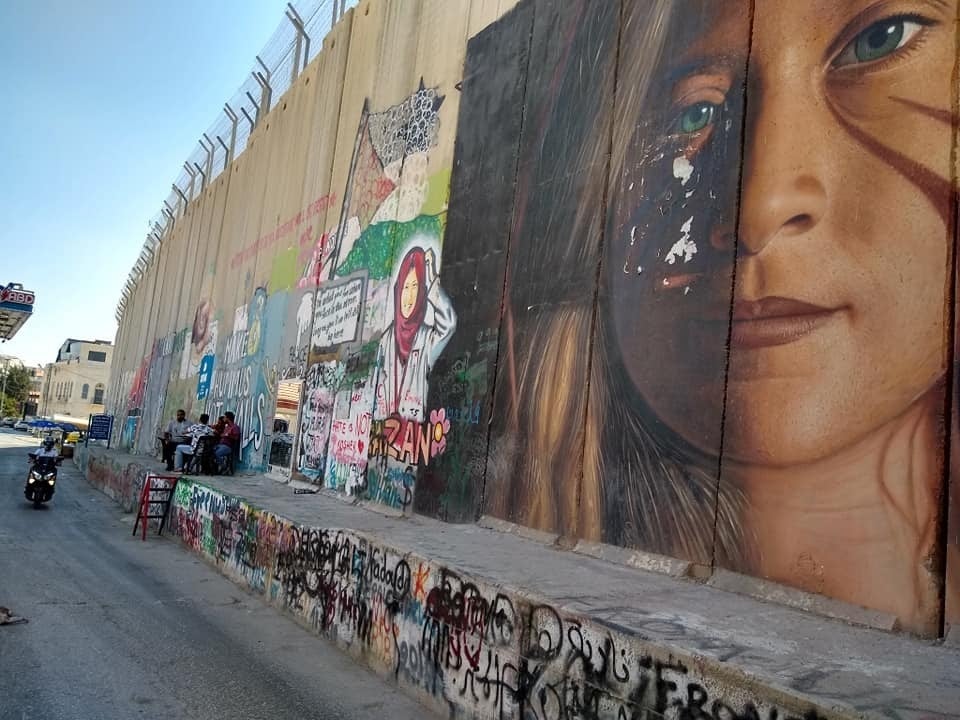O little town: Christmas is cancelled in Bethlehem, but the city still shines with hidden magic
There will be no parades, trees or lights in the biblical birthplace of Jesus this Christmas. Nicholas Blincoe remembers the town he loves in better times – and hopes for a brighter future in the years to come

Christmas is not necessarily the optimal time to visit Bethlehem. Not, at least, this year, after the mayor announced that Christmas is cancelled as a result of Israel’s onslaught on Gaza. But even in the quietest of winters, Bethlehem can seem bleak. The core of the old town, with its ramshackle souk and fortress-like church, is balanced on a high promontory above the desert. The surrounding wilderness is at its most forbidding under wintry skies; the honey-blushed stone loses all its warmth when the sun is wrapped in clouds.
Throughout history, pilgrims have visited at Christmas and returned with jaundiced reports of a colourless town glimpsed under the low winter sun. In recent times, travel writers’ first impressions have been skewed by the 18ft wall that has turned the city into an urban prison, and also by the inflatable Santas and digital versions of “Jingle Bells” that pour from every shop and taxi. The town is not what anyone expects. But a little exploration reveals its magic.

For two and a half thousand years, three reservoirs in Bethlehem’s hills, known as Solomon’s Pools, supplied both Bethlehem and the nearby city of Jerusalem. In December 1917, Welsh infantrymen captured them; British prime minister Lloyd George declared it “a Christmas gift to the British people”. Before the end of the year, Jerusalem had also surrendered.
The three reservoirs are surrounded by a pine wood, Bethlehem’s last accessible bit of countryside. The reservoirs are large and square, like Olympic pools, with terraces that allow ramblers to descend to the water’s edge. It’s a popular picnic spot, despite the glowering Israeli settlements above. Built and rebuilt over millennia, the pools remained in use until 1967, when Israel captured Bethlehem and bypassed the reservoirs by tapping directly into the natural aquifer below.
In Roman times, a high-level aqueduct ran straight along the Bethlehem-Jerusalem road; part of the structure is displayed in a small museum, close to where the Jerusalem road is severed by the wall. Banksy’s brilliant Walled-Off Hotel is just around the corner, a must-visit not only for its collection of original art but also for its museum of Palestinian life under hostile occupation.
Banksy’s brilliant Walled-Off Hotel is just around the corner, a must-visit not only for its collection of original art but also for its museum of Palestinian life under a hostile occupation
Another, more scenic route into town follows the older, Greek-era aqueduct. You can still see furrowed grooves close to the pools, coated in waterproof mortar, a form of construction associated with Nabatean Arabs who built the ancient city of Petra across Bethlehem’s desert on the far side of the Dead Sea. Little of the Greek aqueduct survives, but it is possible to follow its route if you wend your way above the village of Artas, with its polytunnels filled with lettuces, towards Bethlehem.
The aqueduct meanders along the contour lines of the hills, all the way to the site of the Jewish temple in Jerusalem, where it once provided water for the tens of thousands of pilgrims who came from across the ancient world on high days and holidays (and was also useful for sluicing away the enormous amounts of blood from the priests’ animal sacrifices).

The hills are separated by wadis that snake into the wilderness and are filled with caves – a few of which have recently been excavated to reveal Neolithic and Bronze Age funeral chambers. The area around Bethlehem, filled with springs and fertile hills, has been inhabited for 10,000 years, but Bethlehem town, perched on its dry ridge, is only as old as the aqueduct.
It was created in around 300BC as a secure hill fort to protect the waterway, before evolving into a caravanserai and market. Imagine a port town serving a desert rather than a shipping lane. Nomadic traders were both welcomed and feared in the cities of Palestine, and Bethlehem provided a safe place where they could sell perfumes, spices and their livestock.
The biblical story of David is set in an imagined past before Bethlehem existed, but checks off all the ingredients that explain Bethlehem’s importance, both to the region and to Jerusalem’s security: the water, the shepherds, and the cave-filled wilderness beyond the town’s walls.
The city survives because of the single, constant thread of people who call Bethlehem their home, even as ephemeral markers like faith and language shimmer and change
The aqueduct disappears beneath Manger Square and reappears on the far side, where a tiny section is visible inside a gift shop with the misleading name Roman Canal Stores. The square is dominated by the church, a squat, heavy fortress built by the Crusaders and their Armenian allies. Inside, a late-Roman Christian temple is built over the footprint of an even older temple destroyed in the 6th-century Samaritan revolts.
Over the past decade, an ongoing Palestinian-Italian collaboration has seen the church restored, with fabulous frescoes and mosaics rediscovered. The Crusaders were Sicilian-based cousins of the Norse rulers of Normandy and England, and they stamped their presence on Bethlehem in 1099 by painting portraits of Norse saints on the basilica’s columns, alongside pictures of the severed heads of the Sudanese soldiers they had defeated. The Armenians, more kindly, left a carved wooden porch inside the church.
An annual ritual shortly after Christmas sees the entire church cleaned, an event that regularly descends into violence as the heirs of these Crusaders, in the form of Armenian, Latin and Orthodox monks, fight over who has the right to various bits of the church.

There will be no parades, trees or lights in Bethlehem this year – only small religious rites, as the town council and local churches join to ask the international community to stop the attacks on Palestinian civilians. The violence is not restricted to Gaza: Israeli soldiers and settler paramilitaries have killed 500 Palestinians in the West Bank this year, according to UN figures. Friends in Bethlehem report regular raids of the town’s three refugee camps, 450 arrests across the district, and house demolitions in Artas.
The landscape around Bethlehem has been shaped by scores of invasions. Traces of a dozen long-gone empires are folded into the fabric of the city, which survives because of the single, constant thread of people who call Bethlehem their home, even as ephemeral markers like faith and language shimmer and change. They have somehow rolled with the changes and the violence.
I love the city dearly, and only love will ensure the city’s survival. The fear is that Israel has no love at all for a city it has closed off and bypassed, and that it would even, perhaps, rather see it die than survive as a home for Palestinians.
Christmas may not be the best time to visit Bethlehem amid such conflict. But wait for the spring when, for a few brief days, the desert blooms, and the trees are filled with green almonds and Bethlehem’s rare and delicious apricots – and hope is manifested in the promise of new life.
Nicholas Blincoe is the author of ‘Bethlehem: Biography of a Town’, published by Nation Books






Join our commenting forum
Join thought-provoking conversations, follow other Independent readers and see their replies
Comments